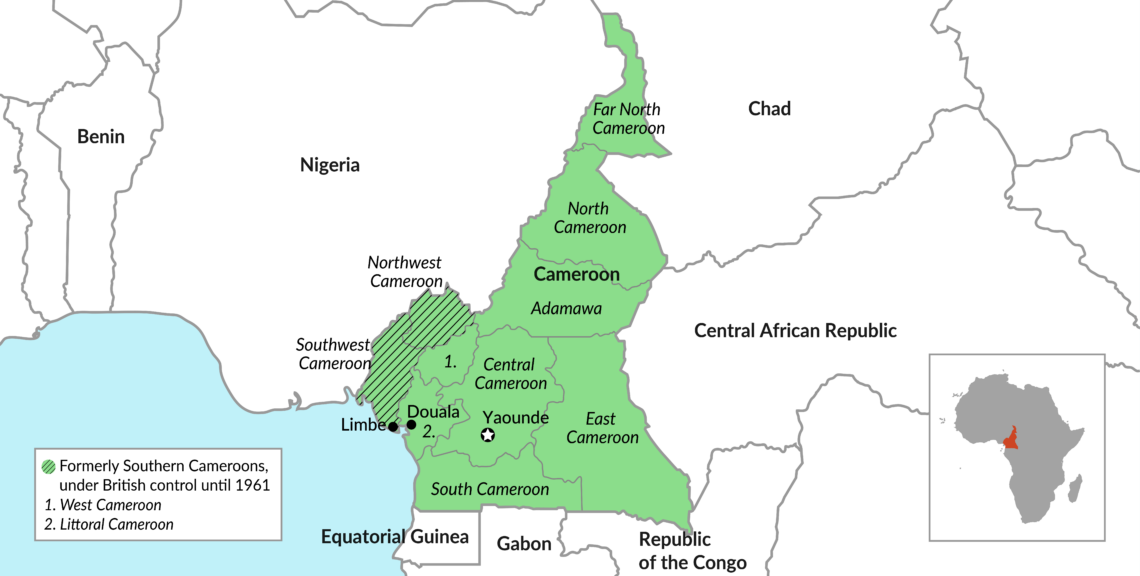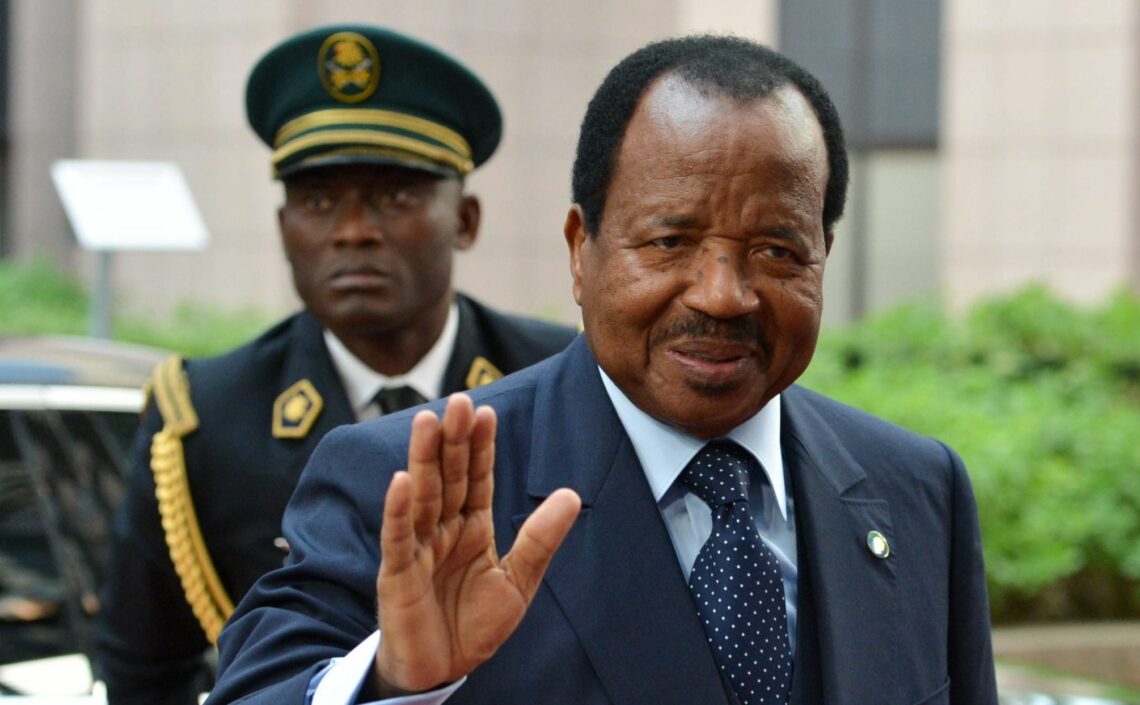Cameroon’s ‘anglophone crisis’ offers a bleak outlook
In Cameroon, separatist forces advocating secession from the rest of the country are gaining clout. Violent clashes are increasing, dragging down the country’s economy. President of Cameroon, is still likely to win a seventh term in office this year, but his eroding legitimacy will make it even more difficult to end the crisis and bring stability back.

In a nutshell
- Separatist forces are gaining support in Cameroon’s English-speaking regions
- The heavy-handed response of President Paul Biya’s regime has exacerbated the situation
- Instability in the country is likely to rise, hurting its economy and potentially leading to civil war
Cameroon’s economic and security outlook is increasingly negative, as violence escalates in the country’s anglophone regions. While the separatist movement and an economic slowdown may not stop President Paul Biya from being reelected for a seventh term, the crisis leaves little room for positive scenarios.
Linguistic divide
The Republic of Cameroon is divided between a French-speaking majority and an English-speaking minority that makes up 20 percent of the country’s population of 23.4 million. This minority is mostly concentrated in the country’s western regions, which were once under British trusteeship and called Southern Cameroons.
Initially a German colony, the territory of Cameroon was split between France and Britain after Germany’s defeat in World War I. The French territory, French Cameroun, became independent in 1960. Following a 1961 plebiscite in the British Cameroons, the predominantly Christian Southern Cameroons territory joined the Republic of Cameroon, forming the two-state Federal Republic of Cameroon.
According to the federal constitution, both regions would maintain independent administrations. Federalism, however, would not last. As in other recently independent African countries, the emerging ruling elites saw regional autonomy as an obstacle to national unity. On the other hand, a centralized state, based on the French model, was considered necessary for development. In 1972, a referendum paved the way for a unitary constitution and the creation of the United Republic of Cameroon.
Power at the national level has been controlled by a francophone elite since 1972.
Despite the formal changes, the two territories maintained different legal and education systems. However, power at the national level has been controlled by a francophone elite since 1972. Cameroon’s anglophone minority has increasingly felt marginalized, complaining that their regions are economically neglected and politically underrepresented.
A big share (90 percent in 2016) of Cameroon’s oil is produced in the English-speaking region, reinforcing the feelings of marginalization. The country’s oil refinery – Societe Nationale de Raffinage S.A., known as Sonara – which is located in Limbe, a city in the oil-rich region of Southwest Cameroon, is controlled by members of the francophone political and economic elite.
While Cameroon is officially a bilingual country, French is used in the country’s administrative, political, monetary and educational systems. Fearing a process of “Frenchification,” anglophone jurists and teachers took to the streets in 2016 to protest the appointment of French-speaking judges and teachers in English-speaking parts of Cameroon, and to demand adherence to Article 1 of the 1996 Constitution, which states that English and French are both official languages, with the same status.
Federalism vs. secessionism
The 2016 protests were mainly organized by teachers and lawyers who formed the Cameroon Anglophone Civil Society Consortium (CACSC). The main goal of the CACSC was not the creation of an independent state but the restoration of the two-state federation. However, the government’s heavy-handed response and the subsequent escalation of violence led to radicalization among English speakers. Secessionists now prevail within the movement.
Those who supported creating an independent state via armed rebellion took control of the anglophone cause.
In January 2017, the government banned the CACSC and arrested some of its leaders, who would be charged under a 2014 anti-terrorism law. At the same time, the government used the Rapid Intervention Battalion of the Cameroon Army – a unit whose effectiveness has improved due to its fight against terrorist group Boko Haram – to repress protesters and rebel groups. This response, seen as disproportionate by anglophone groups, has overshadowed some conciliatory steps taken by the government, like creating a ministry for decentralization and promises of greater local autonomy.
With CACSC out of the picture, those who supported creating an independent state via armed rebellion took control of the anglophone cause, also gaining significant support from the Cameroonian diaspora. On October 1, 2017, militant secessionist groups declared that the Northwest and Southwest regions were now an independent state called the Republic of Ambazonia.
Facts & figures
Cameroon economic data, 2017
GDP: $34.80 billion
GDP growth: 3.2%
Total investment (percent of GDP): 26%
Inflation (average consumer prices): 0.6%
Volume of imports of goods and services (annual percent change): -3.6%
Volume of exports of goods and services (annual percent change): 2.5%
General government gross debt (percent of GDP): 34%
Source: IMF
Biya’s leadership
Divisions within the English-speaking community about how to solve the crisis, with proposals ranging from decentralization to secession, have precluded a unified anglophone movement. The central government has reinforced these differences by appointing anti-secession English-speakers to top jobs, reflecting a divide and rule strategy. Still, the anglophone movement is gaining momentum, and President Biya’s regime has become vulnerable.
Most English-speaking Cameroonians believe Mr. Biya, a French speaker from the south of the country, does not represent their interests. In power since 1982, he is now Africa’s longest-serving head of state. Although he accepted the introduction of multiparty politics in the 1990s and led some important economic reforms, Cameroon remains an authoritarian regime and a poor country. In 2008, amid significant popular protests, a constitutional amendment eliminated term limits and granted immunity to the president after leaving office.

Mr. Biya’s leadership has been sustained by a combination of factors: a politically centralized system and a vast patronage network; the support of the dominant party (the Cameroon People’s Democratic Movement, or CPDM); a polarized or co-opted opposition split into nearly 300 political parties; the careful management of regional, ethnic and linguistic balances; and the loyalty of the military.
Mr. Biya recently announced that he will run for a seventh term in the October presidential elections, with the support of the CPDM. However, after decades in power and with ongoing political and security crises, an economic slowdown and allegations of corruption, the president’s legitimacy has taken a big hit.
The main opposition party is the Social Democratic Front (SDF). It was founded in 1990 and enjoys wide support in the country’s anglophone regions. Joshua Osih, a 49-year-old businessman, will be the SDF’s presidential candidate.
Impact of the crisis
While election years tend to be eventful and President Biya’s regime is increasingly unpopular, under normal circumstances no major political changes would be expected in 2018. However, the anglophone crisis will impact the 2018 elections, as well as Cameroon’s political, security and economic outlook.
There has been a rise in the number and intensity of violent acts committed by both the security forces and the separatists. The Biya regime has been accused of burning entire villages, targeted killings and arbitrary arrests. Many people in the English-speaking regions have fled their villages and are seeking refuge in neighboring Nigeria. Amnesty International estimates that about 150,000 people have been internally displaced.
The emerging humanitarian crisis reflects the rapid deterioration of the security situation at a moment when the country’s military is fighting on two fronts. While clashes with the separatist army, the Ambazonia Defence Forces (ADF), have become more frequent, the Cameroonian Armed Forces continue to fight Boko Haram in the country’s Far North region.
The crisis has also hurt Cameroon’s economy, which was among sub-Saharan Africa’s top performers in recent years. Economic diversification has helped mitigate the negative effects of low oil prices, but Cameroon remains a low-income country, where 25 percent of the population lives on less than $2 a day. The economy slowed down in 2016 and the country is now under International Monetary Fund adjustment measures, including the implementation of a restrictive fiscal policy for 2017-19.
However, the ongoing security crisis is pushing state spending higher. The government recently announced an Emergency Humanitarian Assistance Plan to help the affected areas recover. The cost of the initiative, which will be funded by the state budget and by “national and international solidarity,” is estimated at $22.5 million. The crisis will also threaten much-needed foreign investment. In the Southwest region, the ADF has already called for investors to withdraw from the Etinde floating liquefied natural gas project.
While the security crisis, at least for now, does not directly affect oil production, other sectors – including agriculture and trade – have suffered. Farmers in the Northwest and Southwest regions are being forced to abandon their cocoa plantations, and the instability is restricting trade flows between the border regions and Nigeria.
Furthermore, the shutdown of internet services in the anglophone areas, which account for roughly 20 percent of the country’s gross domestic product (GDP), also hurt the economy. In 2017, the government completely cut off internet access to the English-speaking regions for 93 days. Later that same year, it restricted access to social media and messaging apps in those areas.
Scenarios
Because there are many armed groups without a common goal (some are fighting for an independent Ambazonia, while others call for federalism or decentralization), the anglophone crisis will likely drag out for years. The ongoing violence will put additional pressure on President Biya’s regime and further erode its legitimacy.
In this context, three scenarios can be considered:
Business as usual
Under this most likely scenario, Paul Biya would remain president of Cameroon either by winning the October elections or postponing them. Opposition to the regime would increase among both English- and French-speaking political groups, but their diverging goals would prevent the creation of a viable alternative. To keep a lid on this opposition, President Biya would combine repression with conciliatory measures, including initiatives for dialogue. He would not, however, implement an effective decentralization policy, since it could threaten his leadership.
The international community may condemn the government’s excesses in dealing with separatists, but further pressure is unlikely. Cameroon plays a crucial role in the fight against Boko Haram, and abrupt political change in the country could strengthen the terrorist group.
The crisis would continue to compromise Cameroon’s stability and economy, particularly in the Southwest and Northwest regions. This would aggravate feelings of marginalization among anglophones. Foreign direct investment would continue to fall, and Cameroon would not meet its goal of becoming a middle-income country by 2035.
Civil war
Under a less likely scenario, a downward spiral of violence would lead to a civil war between separatist armed groups and the Cameroon’s security forces. Clashes would escalate significantly during the 2018 presidential elections. While elections would be boycotted or disrupted in the anglophone regions, the francophone opposition would contest the election results which, as expected, would produce a victory for Paul Biya.
Under this scenario, the secessionist cause would reach a point of no return and English-speakers would be further radicalized (including in the opposition SDF). At the same time, the Cameroonian Armed Forces would come under significant strain, fighting Boko Haram in the north and the separatists in the west.
Decentralization or two-state federation
Under this scenario, which is only remotely possible, the Biya regime would make a distinction between the armed groups fighting for separatism and the civil groups that demand adherence to the 1996 constitution. In the first stage, the regime would release activists and reverse changes to the legal and education system, while committing to the implementation of a federalist model in the medium term.
That approach could lead some francophone hardliners to stop supporting Paul Biya’s regime, or even form a coalition against him. Furthermore, it could threaten the stability of the Cameroonian state in the long run, as aspirations for autonomy could emerge in other regions.







